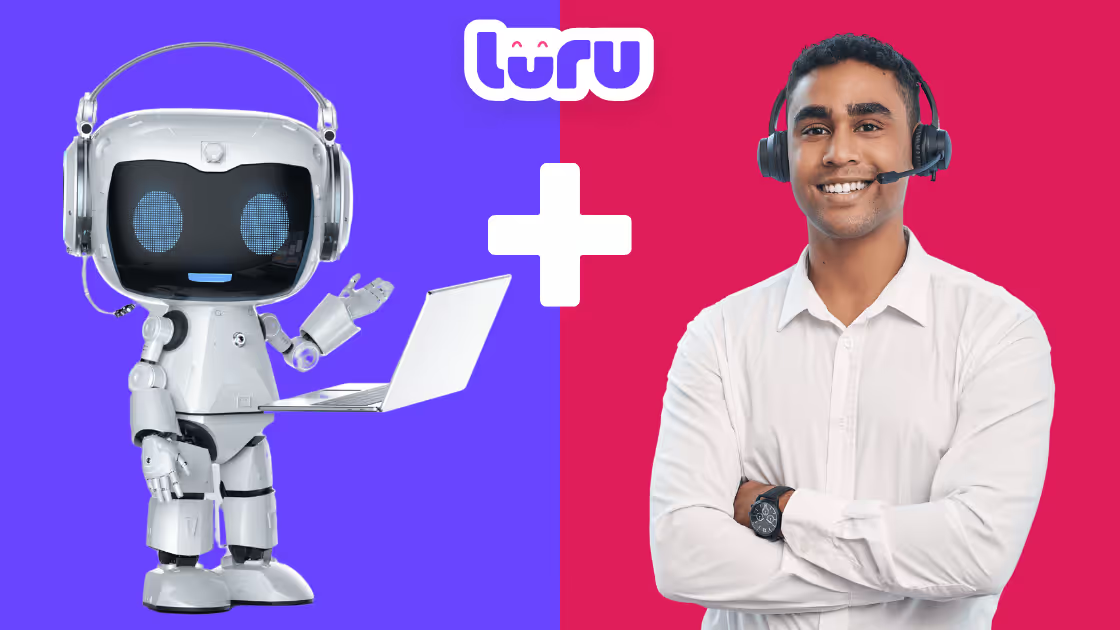Sales Development Representatives (SDRs) are the unsung heroes of the sales process. They’re the ones tasked with finding new prospects, reaching out, and nurturing leads until they're ready for the next step. It's a tough job, and one that demands time, precision, and a lot of patience. But what if we told you that AI could take a lot of that heavy lifting off your plate?
Enter AI SDRs: the technology that’s rapidly transforming how companies approach sales development. AI-powered SDRs are changing the game with the ability to automate repetitive tasks, scale outreach, and offer deep insights into prospects, AI-powered SDRs are changing the game. But here’s the catch—AI isn’t perfect, you still need a human touch to get the most out of AI SDRs. To get the most out of AI SDRs, you still need a human touch. Let’s dive into the real benefits of AI SDRs and why a balanced approach, blending AI and human intelligence, offers the best of both worlds.

AI SDRs Vs Human SDRs
Top 5 Benefits Of AI SDRs
- AI SDRs Can Scale Like Nothing Else
One of the most obvious benefits of using AI in sales development is the sheer scale it can achieve. Humans can only handle a certain number of emails, calls, and follow-ups per day. AI SDR agents, on the other hand, can handle thousands of tasks simultaneously without breaking a sweat. Whether it’s sending out personalized email campaigns or following up with every single lead at just the right moment, AI offers an unprecedented ability to scale outreach efforts. And the best part? It doesn’t get tired or forget.
- Research at Lightning Speed
Sales research is one of the most time-consuming parts of the SDR role. It involves digging through LinkedIn profiles, scanning websites, and collecting details about prospects and their companies. AI SDRs excel here. With access to vast data sets, AI can instantly gather relevant information about prospects, from job titles to company size, recent news, and even personal interests. This allows sales teams to move faster and have deeper, more meaningful conversations with potential leads.
- Consistent Outreach Without Human Error
We all have off days, right? Even the best SDRs can make mistakes—whether it’s sending an email to the wrong person, missing a follow-up, or forgetting a crucial detail about a prospect. AI eliminates those errors. It ensures that every follow-up happens when it’s supposed to, and that every email is personalized just right. No more missed opportunities because of human oversight.
- Personalization at Scale
One of the concerns many people have with AI is that it might make sales feel robotic. But the truth is, AI is actually excellent at personalization when set up correctly. AI SDRs can analyze prospect data and craft emails that speak directly to a potential customer’s pain points or needs. With advanced natural language processing (NLP), AI can write emails that don’t just sound human but also resonate with the recipient on a personal level. This ability to personalize at scale gives sales teams a massive edge.
- Cost-Effective and Efficient
Let’s face it—hiring, training, and maintaining a full SDR team is expensive. AI sales agent software provide a cost-effective alternative for automating many of the tasks that eat up a human SDR's time. By letting AI handle repetitive, lower-value tasks, companies can free up their human salespeople to focus on what they do best—building relationships and closing deals.
Why Cold Calling with AI Is Still Tough
While AI SDRs excel at emails, research, and automating follow-ups, cold calling remains a challenging area for AI to tackle.
- Real-Time Adaptability Is Hard for AI
Cold calling requires the ability to adapt in real-time. Conversations are dynamic, prospects can raise unexpected objections, and a rigid script often won’t cut it. While AI can follow a script and respond based on predefined inputs, it struggles with the kind of improvisation, emotional intelligence, and rapport-building that successful cold calls often demand.
- Legal Concerns Around AI-Generated Voices
There’s also a legal side to consider. In many countries, laws such as the General Data Protection Regulation (GDPR) in Europe have strict rules around AI-generated communications. AI-generated voices are often prohibited or require explicit consent before they can be used in sales conversations.
- AI Voices Lack Human Connection
Even if it’s technically legal to use AI in cold calls, prospects can often tell when they’re speaking to an AI versus a human. The subtle nuances in tone, empathy, and real-time reaction are what make human SDRs effective in these high-stakes conversations. AI-generated voices can feel robotic or impersonal, which may put prospects off.
The Caution: Where AI SDRs Fall Short
While offering immense benefits, AI SDRs are not without their challenges. Relying solely on AI can lead to issues if not carefully monitored and complemented by human expertise.

- AI Lacks Creativity and Strategic Thinking
AI SDRs are excellent at following set rules, but they lack the ability to be truly creative or strategic. AI thrives in structured, data-driven tasks but cannot create novel approaches or strategies. It requires human oversight to ensure that messaging stays aligned with brand voice and adapts to nuanced, high-stakes interactions.
- AI Can "Hallucinate"
AI is not perfect. One of the growing concerns in the AI space is the phenomenon known as “hallucination,” where AI systems generate false or misleading information. An AI SDR might confidently provide the wrong company data or create an inaccurate sales narrative, leading to confusion or loss of credibility with potential leads. This is why it's critical to have humans in the loop to validate information before it reaches a prospect.
- The Artificial Barrier
No matter how advanced AI gets, there’s always going to be something inherently artificial about it. People want to do business with people, not machines. AI SDRs can handle the initial outreach and follow-up, but building trust and rapport is something only a human can do.
How AI SDRs Enhance Outbound & Inbound Sales
- AI SDRs in Outbound Sales
Outbound SDRs juggle time-consuming, repetitive tasks like:
- Email warmup
- Lead discovery & research
- Cold email personalization & outreach
- Follow-ups
AI SDRs automate this entire cycle, freeing human reps to focus on high-intent leads.
- AI SDRs in Inbound Sales
While AI SDRs shine in outbound sales, they also add value to inbound processes. They can:
- Automate meeting scheduling
- Identify high-intent buyers with sentiment analysis
- Transcribe & summarize discovery calls
- Prepare sales meeting agendas
- Craft follow-ups
Future Of AI-SDRs
The future of AI SDRs is unfolding rapidly, with advancements happening in months rather than years. As AI-powered solutions become more reliable. AI SDRs are set to become a standard part of sales teams, evolving beyond outbound tasks like lead qualification and cold outreach. Soon, they will handle call monitoring, direct meeting scheduling, and sales agenda creation, consolidating fragmented sales tools into a seamless AI-driven system. With continuous innovation, AI SDRs will redefine sales development, making processes smarter, faster, and more efficient.
Why a Human + AI Approach Works Best
While AI SDRs bring immense value, they work best when paired with human intuition, creativity, and oversight. A hybrid approach that combines AI’s speed, efficiency, and data analysis with the strategic thinking and emotional intelligence of human SDRs leads to the best outcomes.

At Luru, we understand the need for a balanced approach. We advocate for a "human-in-the-loop" model where AI SDRs handle the heavy lifting—research, outreach, and automation—while human SDRs provide the creativity, strategy, and personal touch. This ensures that outreach is both scalable and tailored, offering the best of both worlds.
Conclusion: Harnessing the Power of AI and Humans in Sales
The benefits of AI SDRs are undeniable—they bring speed, efficiency, and the ability to scale outreach in ways that were unimaginable just a few years ago. But AI’s limitations remind us that the human element in sales is irreplaceable. The best approach is a balanced one—leveraging AI to handle repetitive tasks and data processing while allowing humans to inject creativity, build relationships, and ultimately close deals.
At Luru, we believe in the power of AI, but we also know that the human touch is what drives sales success. That’s why we’ve adopted a human-in-the-loop model, ensuring that our AI SDRs work alongside skilled humans to create a sales process that’s both efficient and deeply personal.















.svg)